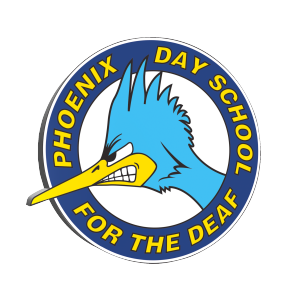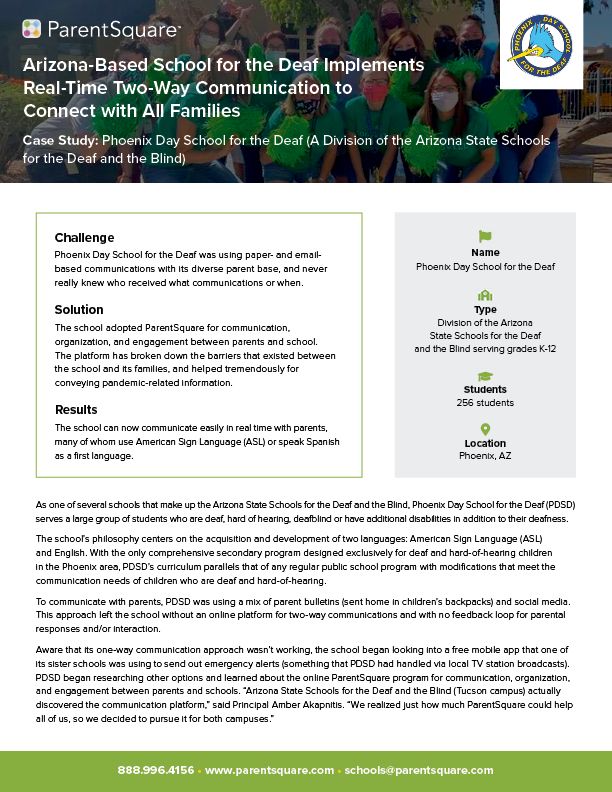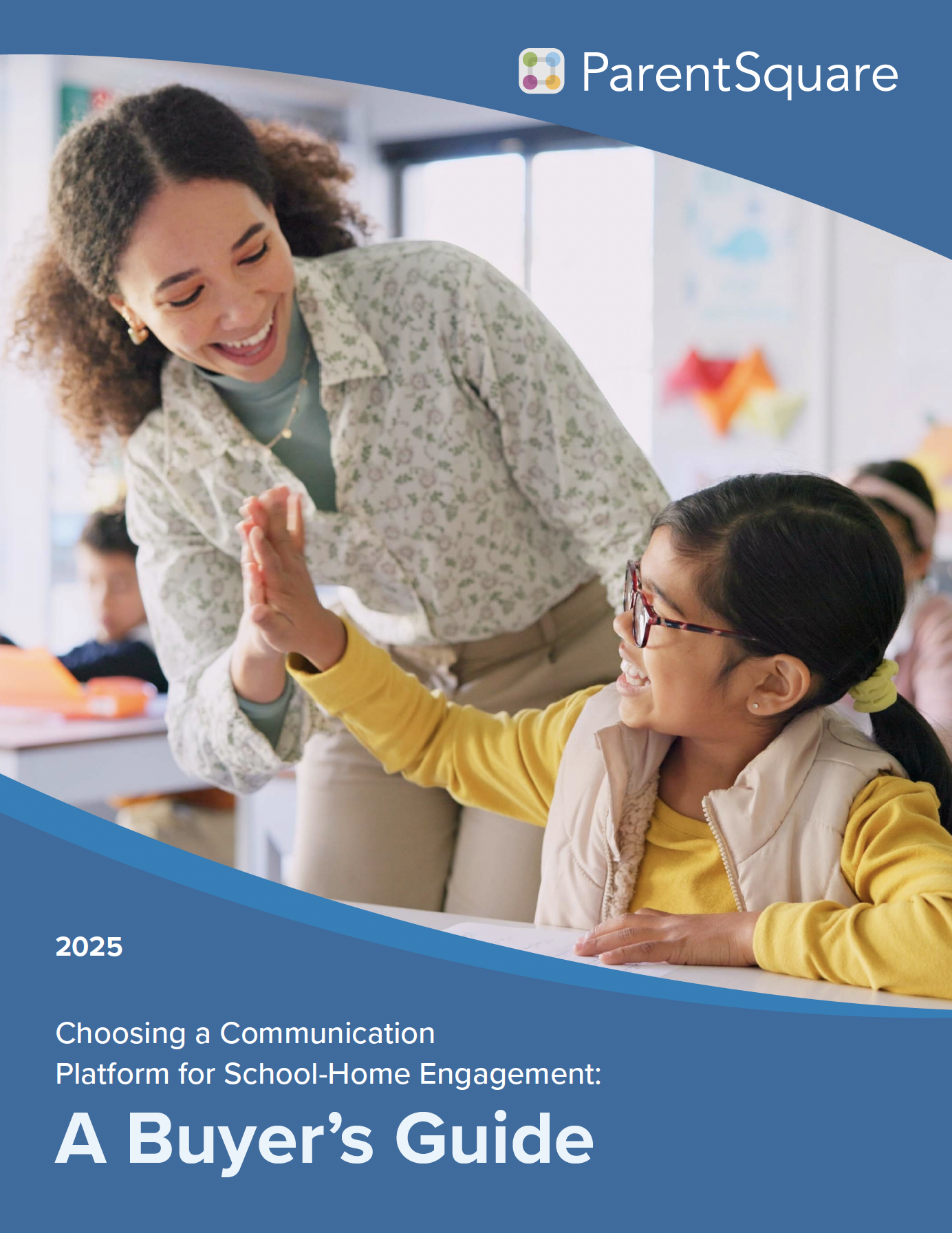
Arizona-Based School for the Deaf Implements Real-Time Two-Way Communication to Connect with All Families
Case Study: Phoenix Day School for the Deaf
(A Division of the Arizona State Schools for the Deaf and the Blind)
Challenge
Phoenix Day School for the Deaf was using paper- and email-based communications with its diverse parent base, and never really knew who received what communications or when.
Solution
The school adopted ParentSquare for communication, organization, and engagement between parents and school. The platform has broken down the barriers that existed between the school and its families, and helped tremendously for conveying pandemic-related information.
Results
The school can now communicate easily in real time with parents, many of whom use American Sign Language (ASL) or speak Spanish as a first language.
As one of several schools that make up the Arizona State Schools for the Deaf and the Blind, Phoenix Day School for the Deaf (PDSD) serves a large group of students who are deaf, hard of hearing, deafblind or have additional disabilities in addition to their deafness.
The school’s philosophy centers on the acquisition and development of two languages: American Sign Language (ASL) and English. With the only comprehensive secondary program designed exclusively for deaf and hard-of-hearing children in the Phoenix area, PDSD’s curriculum parallels that of any regular public school program with modifications that meet the communication needs of children who are deaf and hard-of-hearing.
As one of several schools that make up the Arizona State Schools for the Deaf and the Blind, Phoenix Day School for the Deaf (PDSD) serves a large group of students who are deaf, hard of hearing, deafblind or have additional disabilities in addition to their deafness.
Aware that its one-way communication approach wasn’t working, the school began looking into a free mobile app that one of its sister schools was using to send out emergency alerts (something that PDSD had handled via local TV station broadcasts). PDSD began researching other options and learned about the online ParentSquare program for communication, organization, and engagement between parents and schools. “Arizona State Schools for the Deaf and the Blind (Tucson campus) actually discovered the communication platform,” said Principal Amber Akapnitis. “We realized just how much ParentSquare could help all of us, so we decided to pursue it for both campuses.”
Name
Phoenix Day School for the Deaf
Location
Phoenix, AZ
Students
256 students
Type
Division of the Arizona
State Schools for the Deaf
and the Blind serving grades K-12
“When we put these communications in the recipients’ native language, it truly shows respect for them and helps our parents to have a more comprehensive understanding of what’s going on with their children.”

Amber Akapnitis
Principal
A Phased-In Approach
The first school year that Phoenix Day School for the Deaf adopted ParentSquare, 2019-20, it initially used the platform solely for emergency announcements, and for the staff to practice and make sure it understood how the messages were distributed.However, when the global pandemic emerged in March 2020, Phoenix Day School for the Deaf ramped up its usage of the platform for communicating with parents (primarily for COVID-19 updates). “I quickly inputted all of our parent information into ParentSquare and started using the platform to let them know not to send their children to school,” recalled Akapnitis, “and to inform them about the move to online learning, and what to be on the lookout for from us.”
For the 2020-21 school year, PDSD started using ParentSquare to share events and flyers that it usually would have sent home on paper to communicate updates. “Basically, we’ve taken a phased-in approach to using the platform based on what we can handle and what we felt our parents could handle,” she said. “That approach has worked out really well for us.”
Accommodating Different Languages
The majority of PDSD’s families (54%) speak English or use ASL, while 35-40% are Spanish speaking. Other languages include Kunama (an African dialect), Arabic, and Chuj (a Mayan language with some Spanish influence). ParentSquare handles this diversity of languages, allowing the school to automatically translate into Spanish or add ASL videos to the communications.
“We were using Google Translate and interpreters to manage this process,” said Akapnitis. “Now we can just use ParentSquare and do not always have to wait on the interpreters to let us know if something is being worded and conveyed properly.” The platform also factors in regional nuances for languages like Spanish, further ensuring that the messaging comes across properly for a diverse audience.
“When we put these communications in the recipients’ native language,” Akapnitis added, “it truly shows respect for them and helps our parents to have a more comprehensive understanding of what’s going on with their children.”
Real-Time Responses and Interactions
Thanks to ParentSquare, PDSD’s teachers and administrators no longer have to worry about whether their important, emergency, or routine communications are getting through to parents. “Children don’t always get the notes in their backpacks to their parents in a timely manner,” Akapnitis pointed out. “I’ve found a lot of crumpled up, old notes lying in the bottom of student backpacks.”
With its online communication platform, PDSD avoids this problem and can share information quickly with the people who need it. It’s very easy for parents to access all relevant information, and the platform also creates accountability. “Whereas in the past there was no way to measure whether the parent received the piece of paper or not, now we can see exactly who read what,” she said. “We can see the engagement, tell when parents leave comments, and answer their questions all in one place online.”
Akapnitis enjoys reading that feedback—something she wasn’t able to do before. In fact, parents who have never called the school or attempted to communicate with administrators in the past are now more apt to leave a comment or ask a question. And when she recently posted about a town hall and sent that out on ParentSquare, Akapnitis added an RSVP.
She was pleasantly surprised with the immediate response. “I had four or five families RSVP that day,” said Akapnitis. “Being able to communicate in real-time with families like that was something we were really missing, so we’re thrilled to be able to use ParentSquare in that manner.”

Share This Case Study
Enter your email address below to download a PDF of the case study.







